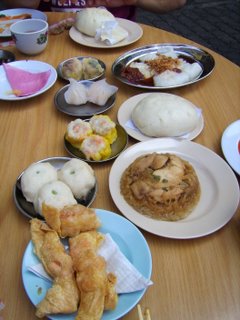Ahh.. Let's talk about Dim Sum today. Dim Sum (點心 pinyin dĭan xīn - literally, "touch the heart", "dotted heart", or "to order to one's heart's content") are little snacks for chinese. They are usually served in delicate portion where you can pop the whole piece of snack at one shot. Each dish usually serve 3-4 pieces. For greedy people like me, I usually ordered till my table is full
 .
.Many many sources have revealed that Dim Sum evolved from teahouses' snacks that were used to position along the Silk Road. Initially only tea and "Pau" or "Man Thou" (both meant steamed bun) were served to business travellers that stopped by for rest, but as economical and cultural borders dissolved, Dim Sum transcended all boundaries and mushroomed all over the world today. Dim Sum nowadays has sooo... many types that if I were to list down all of them, then this blog will never be published (which is one of the reason that this blog is late, would you believe me? hehe..). But as I review Dim Sum in Malaysia, I will reveal to you as much variety as I could taste on. Let's start with the basics this round.
Location: Bukit Menjalara, Kepong, KL
Food rating : Nyum nyum (good)
Review
The few basics that all Dim Sum shops should have is "Char Siew Pau", "Lo Mai Kai", "Chee Cheong Fun", "Har Gau", "Siew Mai" and "Yu Dan". Ok ok, no worries, the Cantonese-English translation is right below:
 Char Siew Pau - Steamed bun with BBQ pork filling
Char Siew Pau - Steamed bun with BBQ pork fillingLo Mai Gai - Steamed glutinous rice with chicken
Chee Cheong Fun - Steamed rice noodles with a choice of prawn or char siew filling
Har Gau - Steamed prawn wrapped in translucent rice-flour skin
Siew Mai - Steamed pork+prawn wrapped in wan ton skin
Yu Dan - Steamed fishball
Wherever I go, I never missed any of these. But it is not easy to find a good Dim Sum restaurant that could serve all the above as evenly tasty. They are either good at Char Siew Pau (like the one in Jalan Ipoh) or some other specific menu. So far, this is the only shop I think offers all treats as good as one another.
I never like Char Siew Pau with thick skin and little filling, as they are too dry and tend to get stuck at my throat. This shop offers balanced skin and filling, and the BBQ pork is very fragrant with 5 spice powder, that is not over-powering.
A lot of Lo Mai Gai in KL is mass-produced, hence they tend to lose freshness when consumed. I believe this shop prepares its own Lo Mai Gai because you can tell if it is fresh, as the glutinous rice is not too soft or too sticky. And again, the spices in this dish is not over-powering with Shao Xing wine.
Har Gau & Siew Mai in KL is really miserable until I found this shop. The usual fair are mostly stuffed with pork (cheaper) or small prawns (again, cheaper), whereas this shop served them in larger prawns that are fairly fresh. Another reason why most shops replace prawns with pork is because you can easily tell a prawn's Dim Sum is fresh or not. I applaud this shop for its chivalrous attempt. (It sounded serious, right? But it is not easy to do what they do.)
The Chee Cheong Fun is ok. Though the rice noodles are a bit too soft, the filling is generous. And the Yu Dan is not too soft or too bouncy (which might mean too much Salicyclic Acid that is harmful to human) or smell too fishy (which might mean not fresh or low quality fish used).
So if you are like me, longing to find some good Dim Sum in KL, this place is recommendable.
By the way, Dim Sum always goes with Chinese Tea. It helps to relief our stomach after we torture it with plates after plates of Dim Sum. And if you sometimes wonder why the elders tend to knock on the table when you pour them a cup of tea, it is not because they are ordering you to pour the tea, but they are thanking you in casual manner. This goes back to Qing Dynasty in the olden China where Qian Long (a Chinese Emperor) went for a secret excursion. This is not usual in the olden days as emperors do not leave their palace. The emperor poured tea for his subordinates (which was an honour) and the subordinates could not kneel down to express their gratitude to the emperor (it is a secret journey, remember?). So what the subordinates did was to bend both the 2nd and third finger and knock on the table to signify their gratitude to the emperor. It became a culture to thank your host when they pour the tea for you until today.
Right... I shall spice things up a bit in the next blog. See you then!
2 comments:
great review..makes me want to grab some dim sums now..haven't had them for ages...watching the waistline...hehehe
Ya... I guess I can understand. As much as dim sum are steamed food, there are a lot of meat and oil. But I guess indulgence once in a while wouldn't kill? hehe
Post a Comment